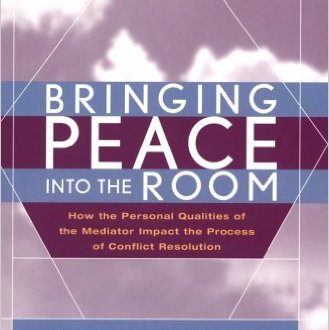One of the best books on the mediation experience—written for mediators about the process experience—is a collection of essays by mediators called “Bringing Peace Into the Room.” (Daniel Bowling and Davide Hoffman, editors, John Wiley & Sons, 2003, 310 pp). Through 13 chapters contributed by a roster of wise mediators, the book sheds light on how an individual mediator’s way of mediating can impact the experience of the disputants in the room. It sounds obvious. Yes, it matters what the mediator does and who she is. Yet the analysis of what is hard to describe is fascinating. It touches on the “heart of the mystery of mediation.” (Thanks, Gary Friedman). Examples of chapters:
- Ken Cloke (one of my favorites, and the author of many books, including “Mediating Dangerously”) has written about “What are the personal qualities of a mediator?” (He calls it their “presence”.)
- Richard Benjamin from the Straus Institute has written a chapter called “Managing the natural energy of conflict: mediators, tricksters, and the constructive uses of deception.” Wait, I thought mediators wanted to discourage deception and advocated transparency! But what about the “tricks” involved in reframing, and structuring the process? How does the mediator use methods to help, not trick, but still bust through boundaries?
- Another mediator, Michelle LeBaron, has written about “Trickster, mediator’s friend”, describing mediators as boundary crossers, with a skill of “stepping over fences and deep trenches” in the conflict. (She has written extensively on the design of the conflict resolution process and multiculturalism in mediation practice.)
- Lois Gold, one of the founders of the Academy of Family Mediators, has written, “Mediation and the culture of healing,” bringing in the topic of spirit, higher consciousness, and relational fields to help clients find their inner wisdom out of the conflict they are experiencing. Again, the presence of the mediator is all important.
- Long associated with the George Mason ICAR program, Sara Cobb wrote a chapter, “Creating sacred space: toward a second-generation dispute resolution practice.”
Reading this book, whether from cover to cover or piecemeal, is a delight, and offers beginners and experienced mediators an opportunity for self-reflection and discussion on how the neutral presence intentionally changes the conflict. Examining this allows the practitioner to be more clear about what works and what doesn’t for that specific case. What a good book for a mediator book group to take on! Highly recommended by Jackie.
P.S. Use Amazon Smile and donate to CMC while buying your books!

